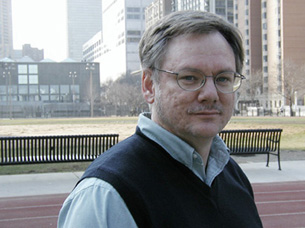Steven Linscott

Steven Linscott (Photo: Jennifer Linzer)
The dream murder — and the wrongful conviction of Steven Linscott
Steven Linscott was wrongfully convicted in 1982 of the murder of a young neighbor woman in Oak Park, Illinois, as a result of prosecutorial and police misconduct and misleading forensic testimony.
After the body of the victim, Karen Ann Phillips, was found, Linscott approached Oak Park police at the urging of friends and told them about a dream he had about a similar murder. Although there were relatively few and not-at-all-amazing similarities between the dream and the actual crime, authorities called Linscott's statement a confession and charged him with murder and rape.
At trial, Assistant Cook County State's Attorneys John E. Morrissey and Jay C. Magnuson told the jury that biological material recovered from the scene had to have come from an O secretor, a relatively small population group that included Linscott. In fact, the forensic evidence established that the material in question could have come not only from an O secretor but also a non-secretor of any blood type — a group that included a sizeable majority of the population.
A state forensic witness, Mohammad Tahir, also had testified that several hairs found on the victim's body, bed, and carpet were consistent with hair samples provided by Linscott. In recent years, microscopic hair comparisons have been shown to be useless.
After the Illinois Illinois Appellate Court reversed the conviction based on prosecutorial misconduct — saying that Morrissey and Magnuson had "invented" the inculpatory blood evidence — the Cook County State's Attorney's Office agreed to DNA testing, which led to Linscott's exoneration in 1992.
In December 2002, Linscott received a pardon based on innocence from Illinois Governor George H. Ryan.
Case Chronology
October 4, 1980 - Karen Ann Phillips is found dead on the floor of her apartment in Oak Park, Illinois.
October 6, 1980 - Steven Linscott, a Bible student living near the murder scene, contacts police, saying that he had a dream about the time of the murder that might help solve the crime.
November 25, 1980 - Linscott is arrested and charged with murder and rape based on written and tape-recorded statements he voluntarily made concerning his dream.
June 16, 1982 - A Cook County Circuit Court jury finds Linscott guilty of murder but acquits him of rape.
November 23, 1982 - Linscott is sentenced to forty years by Judge Adam N. Stillo.
August 7, 1985 - The Illinois Appellate Court reverses Linscott's conviction, holding that proof of guilt was legally insufficient.
October 31, 1985 - Illinois Supreme Court approves Linscott's release on bond.
November 1, 1985 - Linscott is released after 1,802 days behind bars.
October 17, 1986 - Supreme Court holds that the evidence of Linscott's guilt had been legally sufficient and reverses the Appellate Court but remands the case to that court for consideration of issues raised by Linscott but not previously addressed.
July 29, 1987 - Appellate Court again reverses Linscott's conviction, this time based on prosecutorial misconduct, finding that prosecutors misled the jury regarding blood and hair comparisons.
January 31, 1991 - Supreme Court affirms the most recent Appellate Court decision, setting the stage for a retrial.
July 16, 1992 - Cook County State's Attorney Jack O'Malley drops charges against Linscott after DNA tests exonerate him of the rape. O'Malley stops short of proclaiming Linscott innocent, saying only that there is insufficient evidence to try him again for the murder.
December 19, 2002 - Governor George Ryan pardons Linscott based on innocence, entitling him to automatic compensation for his wrongful conviction.
— Rachel Yura

